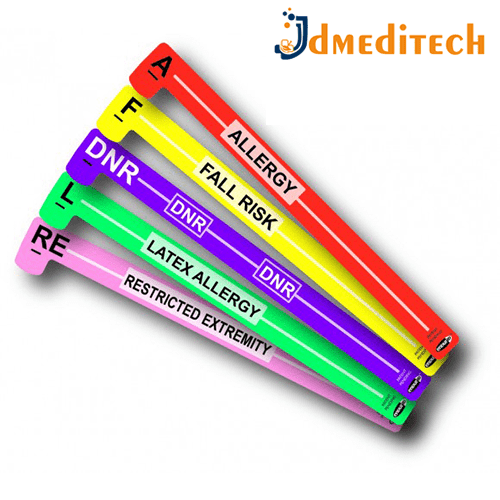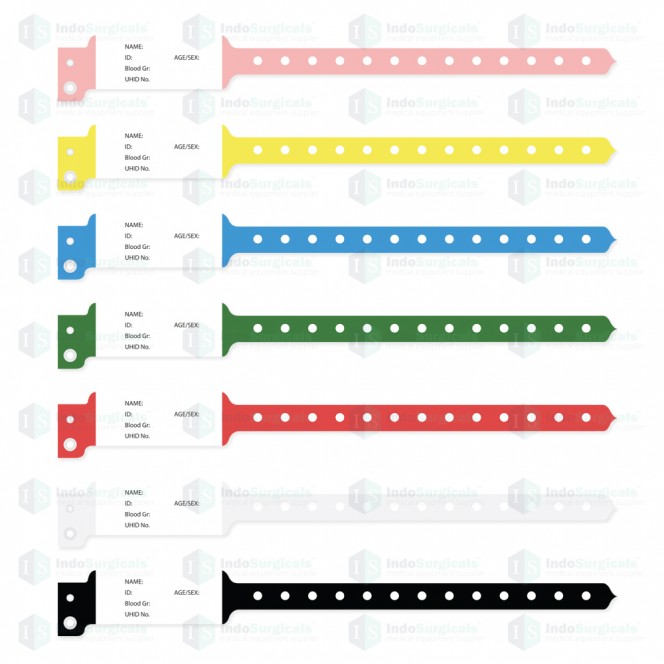Discovering the Numerous Sorts Of Patient Identification Band Used in Clinical Facilities
In the elaborate world of healthcare, the essential role of Patient Identification bands usually goes unnoticed. These bands, differing from straightforward paper wristbands to sophisticated RFID bands, create the foundation of Patient safety and security protocols, ensuring precision in Patient Identification. The substantial variety of these bands, each with its special advantages and constraints, is commonly forgotten. As we navigate through this subject, one might obtain understanding into the subtle complexities and vital value of such bands in clinical centers.
Recognizing the Relevance of Patient Identification Bands
While they may seem like simple accessories, Patient Identification bands play a vital function in medical centers. These bands offer as a vital device for confirming Patient identity, avoiding medical mistakes related to misidentification. Patient Identification bands also help in enhancing management tasks, ensuring precise record-keeping and billing.
Standard Paper Wristbands: Their Use and Limitations
Traditional paper wristbands have been a staple in Patient Identification across various clinical centers. While their usage is prevalent, they nurture specific limitations that might impact their performance in Patient administration. This area will certainly concentrate on the range of their application and the inherent disadvantages connected with their usage.
Paper Wristbands: Usage Range
In the realm of Patient Identification, paper wristbands have long held a vital duty. These bands are commonly utilized in outpatient settings, where the Patient's keep is short-term. The wristbands contain essential details such as the Patient's name, date of birth, and an unique Identification number. This basic, yet efficient system, allows medical experts to rapidly and accurately recognize patients, guaranteeing the right therapy is administered. Paper wristbands are likewise utilized in emergency situation circumstances, where fast Identification is extremely important. Their use includes events like blood donation drives and mass vaccination programs, even more highlighting their adaptability. Despite improvements in technology, the humble paper wristband continues to be a economical and reputable solution for Patient Identification in numerous medical care circumstances.
Limitations of Paper Wristbands
In spite of their extensive use, paper wristbands are not without their disadvantages. In enhancement, paper wristbands frequently lack the technological capabilities of even more modern-day alternatives, such as barcoding or RFID chips, restricting their functionality to just presenting composed details. Paper wristbands can trigger discomfort or skin inflammation to some clients, especially when used for extensive durations.
Barcoded Wristbands: Developments in Patient Identification
While Patient Identification has actually long been an essential element of healthcare, the advent of barcoded wristbands signifies a substantial jump onward. These bands leverage the simplicity of barcoding technology, permitting Patient details to be promptly scanned and accessed. They boost the rate and precision of Patient Identification, decreasing the risk of clinical errors associated to misidentification. Barcoded wristbands are affordable, simple to create, and get rid of handwriting errors typical with manual systems. Nevertheless, they are not without limitations. While they use renovations over conventional bands, the barcode can come to be smudged or used, providing it unreadable. In spite of this, barcoded wristbands continue to be a crucial tool in modern-day healthcare settings, representing the junction of innovation and Patient treatment.
Superhigh Frequency Identification (RFID) Bands: a Step In The Direction Of Futuristic Health Care
The development of Patient Identification bands has caused the introduction of Superhigh frequency Identification (RFID) Bands (patient identification band). These cutting-edge devices present essential advantages for healthcare centers, supplying a much more effective and technologically progressed methods of Patient Identification. The implementation of RFID in health care is a substantial action in the direction of an extra futuristic approach to Patient administration and security
Comprehending RFID Bands

RFID Bands: Key Advantages
Accepting a future where innovation and healthcare merge, radio frequency Identification bands provide numerous essential benefits. Mostly, these bands boost Patient safety and security by providing precise, instant Identification, consequently minimizing clinical mistakes. RFID bands can keep a huge amount of Patient information, consisting of case history and allergies, allowing individualized treatment. They additionally enhance management jobs, as the automated data entrance changes hand-operated processes, improving effectiveness and lowering paperwork. Furthermore, RFID bands supply real-time monitoring of people, important in risky environments such as surgical treatment or intensive care. These bands are durable and resistant to ecological aspects, ensuring regular functionality. Generally, RFID bands stand for a considerable advancement in Patient Identification innovation, profiting both people and medical care companies.
Carrying Out RFID in Healthcare
As we step into my explanation a technologically advanced period, the implementation of RFID bands in medical care comes to be increasingly important. These bands provide a smooth means to track and identify individuals, ensuring their safety and security and improving navigate to these guys effectiveness in treatment procedures. RFID bands provide countless benefits over conventional Identification techniques. They can save a substantial quantity of information, including the Patient's clinical background and therapy strategies, which can be quickly accessed by doctor. This data aids medical professionals make educated decisions regarding the Patient's treatment plan. RFID bands reduce medical errors by offering precise Patient Identification, which is vital in preventing misdiagnosis or incorrect medication administration. Therefore, the application of RFID bands is a considerable step towards enhancing Patient safety and health care shipment.

Color-Coded Wristbands: Helping in Quick and Accurate Medical Diagnosis
In the bustling environment of a medical facility, color-coded wristbands have become important devices for swift and accurate Identification of a person's clinical problem. These wristbands, worn by people, lug details colors that match to different medical problems or conditions. image source As an example, red can indicate allergic reaction dangers, while yellow may indicate a loss danger. This system is created to use immediate visual signs to doctor, improving Patient security and care high quality. In emergency circumstances, the use of these wristbands enables for fast decision-making. Nonetheless, the effectiveness of color-coded wristbands depends upon the harmony of shade interpretation throughout health care institutions, requiring common criteria for constant application.
Approaches for Reliable Application and Management of Patient ID Bands
Accomplishing ideal use of Patient Identification bands necessitates a well-structured method for their application and monitoring. Patient education is likewise important; patients need to comprehend the purpose of the bands and the need for their continuous wear. It's necessary to have a back-up plan in location, such as barcode scanning or biometrics, to make sure that Patient Identification is never ever jeopardized.
Verdict
Patient Identification bands are important in medical facilities to make certain security and precision. Standard paper, barcoded, RFID, and color-coded wristbands each hold distinct benefits, varying from cost-effectiveness to innovative information storage and immediate clinical alerts. Effective implementation and management of these bands can significantly reduce clinical mistakes, boost efficiency, and improve general Patient care. Hence, understanding and using these Identification tools is extremely important for preserving high standards in healthcare.
These bands, differing from straightforward paper wristbands to sophisticated RFID bands, develop the foundation of Patient safety procedures, guaranteeing precision in Patient Identification.The advancement of Patient Identification bands has brought about the emergence of Radio Regularity Identification (RFID) Bands. Overall, RFID bands represent a substantial improvement in Patient Identification technology, benefiting both individuals and medical care service providers.
RFID bands minimize clinical errors by offering precise Patient Identification, which is critical in stopping misdiagnosis or wrong medication management. Patient education and learning is also critical; individuals should recognize the objective of the bands and the requirement for their continuous wear.
Comments on “The Impact of a Patient Identification Band in Improving Hospital Patient Tracking Systems”